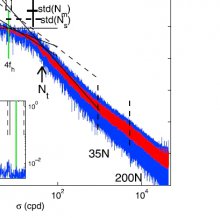Oceanic fine structure has been studied since the development of CTD and microstructure profilers allowed to
resolve the vertical scales of temperature and salinity in the ocean. In the context of internal waves, it rapidly
appeared that the advection of oceanic fine-structure may lead to erroneous interpretations of temperature measurements,
and much theoretical work was achieved to distinguish real internal wave signal from the so-called
fine-structure contamination. The pioneering work of Phillips (1971) revealed how the vertical advection of temperature
steps by internal waves contaminates temperature records at fixed depths. Fine-structure contamination
can be recognized in the super-buoyant part of the spectrum as a typical -2 slope, theoretically predicted for sharp
stair cases in the temperature profile.
However, distinguishing fine-structure contamination from other (turbulent) signals in real datasets is sometimes
difficult. We will show how the use of a large number of highly accurate temperature sensors allows to completely
resolve the fine-structure contamination sketch. More precisely, the coherence spectrum between vertically separated
sensors shows a characteristic pi-phase signature above the Brunt-Väisälä frequency N that we can reproduce
using a simple kinematic model.
The dataset used consists of temperature time series (1Hz during 1.5 year) obtained in the Canary Basin. Over a
range of 132.5m, 54 NIOZ High Sampling Rate Thermistors (NIOZ-HST, 1mK relative accuracy) were moored
around 1455m. Coherence between individual records shows a weak, but significant peak above N for all vertical
separations. Instead of a dominant 0-phase difference over the range of sensors, as observed for internal waves
at frequencies f < -omega < N, f denoting the inertial frequency, this super-buoyancy coherence shows pi-phase
difference over a frequency band, that shifts to higher frequencies as the vertical separation between thermistors
diminishes. In the time domain it is observed that this high frequency coherence mainly occurs when non-linearities
in the temperature gradient, such as steps in the temperature profile, are advected passed the sensors. A kinematic
model of fine structure contamination successfully reproduces these observation.
Surprisingly, the canonical -2 slope of the temperature spectrum above N is not observed in the in situ data, which
rather slope like -8/3. The -8/3 slope can nevertheless be reproduced in our kinematic model, in which there is no
turbulence, provided the jumps in the temperature profile are not infinitely thin.





